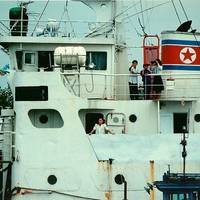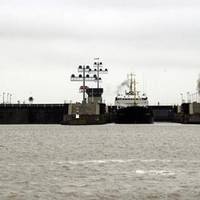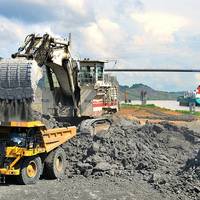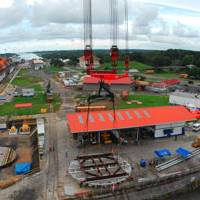Panama Canal launches Incentives for Cleaner Shipping
Today, the Panama Canal launched the Environmental Premium Ranking, a new initiative that rewards customers who meet high environmental efficiency standards. The new incentive allows qualified customers the opportunity to improve their position within the Panama Canal’s Customer Ranking System, which is taken into consideration when booking for transit through the Panama Canal. This latest initiative is part of the Canal’s Green Connection Environmental Recognition Program, which recognizes customers who demonstrate excellent environmental stewardship and to encourage others to implement technologies and standards to help reduce greenhouse gas emissions.
Deck Cooling While Transiting Panama Canal
Effective immediately, and until further notice, the Panama Canal Authority (ACP) will require transiting crude oil tankers, product carrier, and chemical tankers carrying cargoes with flashpoint of less than 18 deg. C, to cool their main decks with water by means of the on-deck water sprinkler system or any other means available in order to prevent automatic activation of their pressure relief valves during transit. The cooling of the main deck shall be performed between 1000 and 1600 hours while the vessel is underway at Gatun Lake or Gaillard Cut, or at anchor in Canal waters. However, this procedure should be stopped while the vessel is transiting through the locks or is in the vicinity of the locks, and when Canal deckhands are on board.
Panama Canal Takes Steps to Shrink Wait Times

Aiming to help accommodate unseasonably high demand, the Panama Canal Authority (ACP) announced it has taken a number of steps to expedite traffic and decrease Canal Waters Time (CWT). The ACP has postponed noncritical maintenance work, modified bookings and assigned additional operations personnel. As a result, the canal has made steady progress, according to ACP. ACP said current wait times for transiting ships have been reduced and now stands at four days or less. Moreover, the number of ships awaiting transit has been cut by 40 percent from its recent high in October.
Preventive Measures at Panama Canal Against Ebola
The Panama Canal Authority, in coordination with the country's Ministry of Health (MINSA), is taking the following measures to prevent the spread of the Ebola Virus Disease (EVD) and protect Canal workers and customers. The Maritime Sanitation Unit of MINSA is the authority responsible for investigating and authorizing the necessary clearance to board vessels with suspicious or reported EVD cases. * The Authority is continuously monitoring the last 10 ports of call for all vessels arriving at Canal waters and will immediately alert MINSA's Maritime Sanitation representatives of any vessels arriving in Canal waters whose previous 10 ports were from an Ebola affected country.
2nd Shipment Of Gates Arrive At Panama Canal
In another step forward for the Panama Canal Expansion Program, the second shipment of four rolling gates for the Third Set of Locks arrived today from port of Trieste, Italy to the waterway's Atlantic side on board the semi-submersible heavy lift vessel Sun Rise. "This is another milestone as it completes half of the 16 gates that will be used in the new locks", said the administrator of the Panama Canal Authority, Jorge Luis Quijano. Following a nearly one-month long journey, the ship completed its second trip that began in mid-May in the Port of Trieste, crossing the Mediterranean Sea and the Atlantic Ocean. Differing from the first shipment, these gates have two different dimensions, according to their final position in the lock chambers.
North Korea Arms Carrier Pays Panama Canal Fine

The Panama Canal Authority (ACP) informs that representatives of the ship 'Chong Chon Gang' have paid the total amount of the fine for US$693,333.10 set due to the violation of the Regulations for Navigation in Canal Waters and consequently the ACP has authorized the release of the ship. ACP add that in the case of the ship Chong Chon Gang, its competence was limited to the violation of the vessel to Canal regulations, and is not related to any other fault outside Panama Canal jurisdiction.
Advisoty to Shipping for Panama Canal
The Panama Canal Authority (ACP) requires that all vessels navigating in Panama Canal waters comply with the manning requirements in order to guarantee a safe and expeditious transit or docking maneuver at the ports located at both ends of the Canal. In addition, “The crew must meet the standards set forth in the International Convention on Standards of Training, Certification and Watchkeeping for Seafarers, 1978/95 (STCW).”Article 103.1 (Annex) of the regulations requires transiting vessels to have sufficient seamen forward and aft to handle lines expeditiously during lockages, as well as when moored temporarily to lock walls or inside a lock chamber. The Canal requires transiting vessels to provide, as a minimum, one officer and two seamen forward and after respectively.
Kiel Canal Remains Closed

The Kiel Canal remains closed due to prevailing adverse weather and the instability of a damaged vessel involved in a collision yesterday, October 28. Salvage works are currently underway. As the damaged vessel has not yet been stabilized sufficiently and bunker oil is penetrating into the Kiel Canal waters, the Canal Authority has decided to maintain the closure for another 24 hours until at least midday tomorrow, October 30. gac.com
Panama Canal Pre-Arrival Information

The Panama Canal Authority would like to remind its customers of the requirement to submit the 'Ship Due Information' through the Electronic Data Collection System (EDCS) at least 96 hours prior to the vessel's arrival at Canal waters. The timely submission of this information is crucial to the implementation of the pre-arrival inspection process. Failure to provide accurate, timely and complete information may classify the vessel as "not ready", and may delay the vessel's transit and/or harbor movement until the information is received and the "not ready" status is lifted.
Panama Canal Pilotage Regulations and Training of Pilots
The Panama Canal said it enjoys an excellent safety record, which it credits mainly to the extensive training required of its pilots. To continue providing this service, training on board transiting vessels is essential. Nevertheless, a number of recent reports have brought to the canal's attention the reluctance of several masters to allow Panama Canal pilots in training to maneuver their vessels under the supervision and control of qualified Panama Canal pilots as part of their required training program, the canal said. Pilotage is compulsory in canal waters based on the Regulation on Navigation in Panama Canal Waters, Article 90, Section One, Chapter V, Pilotage.
New Panamax Vessel Requirements

The Panama Canal Authority (ACP) issued a release reminding customers that vessels arriving at Canal waters, whether for docking or transiting the Panama Canal, must comply with vessel requirements, as stated in the Maritime Regulations for the Operation of the Panama Canal and OP’s Notice to Shipping No. ACP said the purpose of the advisory is to inform the shipping community of the definitions and requirements applicable to all vessels intending to transit the Panama Canal’s new locks. at 29.4ºC. (Note: Transition to fresh water frequently alters trim of large vessels by the head).
Panama Canal Sets New Tonnage Record

The Panama Canal set a mark in its history as it reached a new tonnage record of 333.7 million Panama Canal tons (PC/UMS) during fiscal year 2012 which concluded on September 30. This achievement highlights the value of Panama and its significance as a link in the chain of global trade. "This milestone attests to the reliable and continuous service offered by the Canal, which is supported by a workforce of 10,000 men and women. The Panama Canal works tirelessly to provide its customers with first-rate service…
ACP Issues Single Hull Tanker Guidelines for Transit
Conscious of its responsibility to safeguard its waterway, the Panama Canal Authority (ACP) has determined that effective December 31, 2012, single hull (single side/single bottom, single side/double bottom, or double side/single bottom) oil tankers of 600 tons deadweight and over but below 5,000 tons deadweight will no longer be allowed to transit the Panama Canal if loaded with oil (as defined in MARPOL, Annex I). In the meantime, when aforementioned tankers arrive for transit loaded with oil, they will be assigned extraordinary tug assistance at all locks and through Culebra Cut at the vessel’s expense. Category 2 and 3 oil tankers with extensions granted in accordance with regulations 20.5 and 20.7 of MARPOL…
Panama Canal FY 2010 Q1 Metrics
The Panama Canal Authority (ACP) released first quarter (Q1) operational metrics for fiscal year 2010. In Q1, Canal Waters Time (CWT), the average time it takes a vessel to transit the Canal (including waiting time for passage) significantly decreased. There also were increases in total transits and net tonnage. These metrics are based on operations from October through December 2009, the first quarter of the ACP's 2010 fiscal year, and are compared with Q1 of fiscal year 2009. CWT decreased 27.5 percent – to 20.29 hours from 27.97 hours. CWT for booked vessels, those ships holding reservations, also experienced a decrease of 20.7 percent – to 13.43 hours from 16.94 hours. Total Canal transits increased two percent – to 3,590 transits from 3,520.
Panama Canal Authority FY 2009 Metrics
The Panama Canal Authority (ACP) announced its operational metrics for the 2009 fiscal year (FY 2009). Most importantly, Canal Waters Time (CWT), the average time it takes a vessel to navigate the Canal, including waiting time, significantly decreased. Fiscal year 2009 (October 2008 – September 2009) statistics show a slight decline in total transits and tonnage compared to FY 2008. In addition, the Canal experienced growth in some principal segments, most notably, general cargo, dry bulk, and tanker transits. In FY 2009, CWT decreased 26.9 percent – from 31.55 to 23.06 hours. For booked vessels (those ships holding reservations), CWT declined 16.1 percent – from 18.52 in FY 2008 to 15.54 hours this year.
Panama Canal Authority FY2009 Q3
The Panama Canal Authority (ACP) released third quarter (Q3) operational metrics for fiscal year 2009. In Q3, Canal Waters Time (CWT), the average time it takes a vessel to transit the Canal, including waiting time for passage, decreased significantly. Additionally, total transits and net tonnage decreased slightly. These metrics are based on operations from April through June 2009, the third quarter of the ACP's 2009 fiscal year, and are compared with Q3 of fiscal year 2008. Average CWT decreased 47.9 percent – to 19.96 hours from 38.31 hours. CWT for booked vessels (those ships holding reservations) decreased 26.5 percent – to 14.53 hours from 19.77 hours. In Transit Time (ITT) also decreased 26.6 percent – to 9.55 hours from 13.02 hours.
Track & Turntable System for Panama Canal

The Panama Canal Authority (ACP) updated its track and turntable system located in the Canal’s Gatun Locks. The system continuously transports locomotives through the locks to assist transiting vessels. Previously, vessels stopped midway through the locks to exchange locomotives, increasing Canal Waters Time or the average time it takes a vessel to navigate the Canal. The new system enables two additional Panamax vessels to transit the waterway every day. “The new track and turntable system significantly enhances the efficiency and safety of the Canal…
Panama Canal Authority 2009 Q2 Metrics
The Panama Canal Authority (ACP) released second quarter (Q2) operational metrics for fiscal year 2009. In Q2, Canal Waters Time (CWT), the average time it takes a vessel to transit the Canal, including waiting time for passage, decreased significantly, while total transits and net tonnage remained nearly flat. These metrics are based on operations from January through March 2009, the second quarter of the ACP's 2009 fiscal year, and are compared with Q2 of fiscal year 2008. Average CWT decreased 27.9 percent – to 26.22 hours from 36.39 hours. CWT for booked vessels (those ships holding reservations) decreased 19.5 percent – to 15.83 hours from 19.66 hours. The drop in CWT can be attributed to the ACP’s efficient operations and a slight decline in transits.
Panama Canal 4Q Metrics

The Panama Canal Authority (ACP) released fourth quarter (Q4) operational metrics for fiscal year (FY) 2008. These metrics are based on operations from July through September 2008, the fourth quarter of the ACP's 2008 fiscal year and are compared with Q4 of FY 2007. In Q4 of FY 2008, tonnage decreased minimally, but tanker and passenger transits and tonnage jumped significantly. During Q4 of FY 2008, Canal Waters Time (CWT), the average time it takes a vessel to transit the Canal (including waiting time for passage), decreased nearly 10 percent to 26.73 hours from 29.61 hours in Q4 of FY 2007.
Panama Canal Announce Results

The Panama Canal Authority (ACP) announced its operational metrics for the 2008 fiscal year (FY 08). Year-end (October 2007 – September 2008) statistics reveal a marginal decline in total transits and tonnage when compared to FY 07. However, the Canal also experienced growth in core segments, most notably tanker and passenger transits. transits remained fairly constant, with a slight decline of 0.1 percent – from 14,721 to 14,702 transits. Booked transits (excluding auctioned slots) increased 3.9 percent – from 7,857 to 8,167 transits.
Panama Canal Releases 2Q Data
Total Canal transits decreased 2 percent during Q2 – from 4,053 to 3,971 transits. Panama Canal/Universal Measurement System (PC/UMS) tonnage also dropped 2.6 percent – from 80.4 million PC/UMS tons to 78.4 million PC/UMS tons. Passenger transits increased 34.8 percent – from 92 to 124 transits – while dry bulk transits rose 6.7 percent, from 586 to 625 transits and dry bulk cargo tonnage increased 10.4 percent, from 12.3 to 13.5 million PC/UMS tons. The number of containers, vehicle carriers, tankers and general cargo dropped when compared to figures for FY 2007. Refrigerated cargo transits slightly decreased, by 1.4 percent, but refrigerated cargo tonnage increased 1.1 percent – from 5.6 million PC/UMS tons to 5.7 million PC/UMS tons.
Panama Canal Shipboard Oil Pollution Emergency Plans
The Panama Canal Authority issued an Advisory stating that a new Section Four has been added to Chapter IX of the Regulation on Navigation in Panama Canal Waters. The new articles require vessels transiting the Canal to have Panama Canal Shipboard Oil Pollution Emergency Plans (PCSOPEPs), among other things. The PCSOPEPs must include identification of the oil spill removal organization (OSRO) previously reviewed by the Panama Canal Authority and hired by the vessel to conduct appropriate cleanup tasks in the event of an oil spill. The PCSOPEP must be submitted for review by the Authority. The new requirements come into effect on January 1, 2004. Source: HK Law
Calibration of Magnetic Compasses in Panama Canal Waters
The Panama Canal Authority issued an Advisory reminding masters that, if they elect to calibrate their magnetic compasses while in Panama Canal Waters, they must sign the Authority boarding officer’s inspection checklist, corroborating that the magnetic compass was serviced using appropriate procedures and that the equipment is in proper working order for transit. Advisory 34-2003 Source: HK Law









